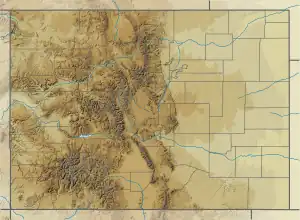Dunsinane Mountain
Dunsinane Mountain, or officially Dunsinane, is a 12,742-foot-elevation (3,884-meter) mountain summit located in Hinsdale County, of Colorado, United States.[3] It is situated 11 miles east of the community of Ridgway, in the Uncompahgre Wilderness, on land managed by Uncompahgre National Forest. It is part of the San Juan Mountains which are a subset of the Rocky Mountains, and is situated west of the Continental Divide. Topographic relief is significant as the east aspect rises 2,500 feet (760 meters) above the Middle Fork Cimarron River valley in approximately one mile. The mountain's name was officially adopted as Dunsinane by the United States Board on Geographic Names in 1966, and is so named because it resembles the castle Dunsinane of Shakespeare's Macbeth.[3][5]
| Dunsinane Mountain | |
|---|---|
 Southwest aspect | |
| Highest point | |
| Elevation | 12,742 ft (3,884 m)[1] |
| Prominence | 582 ft (177 m)[1] |
| Parent peak | Precipice Peak (13,144 ft)[2] |
| Isolation | 0.74 mi (1.19 km)[2] |
| Coordinates | 38°07′47″N 107°32′21″W[3] |
| Naming | |
| Etymology | castle Dunsinane |
| Geography | |
 Dunsinane Mountain Location in Colorado  Dunsinane Mountain Dunsinane Mountain (the United States) | |
| Location | Hinsdale County Colorado, US |
| Parent range | Rocky Mountains San Juan Mountains |
| Topo map | USGS Courthouse Mountain |
| Climbing | |
| Easiest route | class 4[2] North ridge[4] |
Climate
According to the Köppen climate classification system, Dunsinane is located in an alpine subarctic climate zone with cold, snowy winters, and cool to warm summers.[6] Due to its altitude, it receives precipitation all year, as snow in winter, and as thunderstorms in summer, with a dry period in late spring. Precipitation runoff from the mountain drains into tributaries of the Cimarron River.
Gallery
See also
- Chimney Rock
- Mountains of Hinsdale County, Colorado
References
- "Dunsinane Mountain, Colorado". Peakbagger.com.
- "Dunsinane Mountain - 12,742' CO". listsofjohn.com. Retrieved 2021-07-06.
- "Dunsinane". Geographic Names Information System. United States Geological Survey, United States Department of the Interior. Retrieved 2021-07-06.
- Robert F. Rosebrough, The San Juan Mountains: A Climbing & Hiking Guide, Cordillera Press, 1986, page 224.
- United States Board on Geographic Names, Decisions on Geographic Names in the United States, Decision List No. 6602, 1966, page 7.
- Peel, M. C.; Finlayson, B. L.; McMahon, T. A. (2007). "Updated world map of the Köppen−Geiger climate classification". Hydrol. Earth Syst. Sci. 11. ISSN 1027-5606.
External links
- Dunsinane: Weather forecast
- Dunsinane Mountain Climbing: Mountainproject.com

